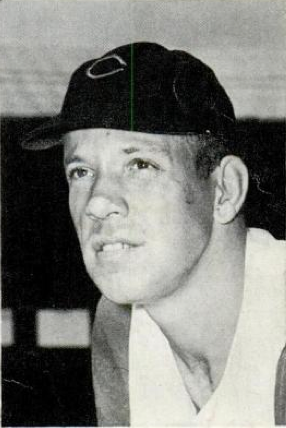
Joseph Henry Nuxhall was an American left-handed pitcher in Major League Baseball, primarily for the Cincinnati Reds. Immediately after retiring as a player, he became a radio broadcaster for the Reds from 1967 through 2004, and continued part-time up until his death in 2007. Nuxhall held the team's record for career games pitched (484) from 1965 to 1975, and still holds the team mark for left-handers. In addition to his 40 years of broadcasting Reds games, Nuxhall is most remembered for having been the youngest player ever to appear in a Major League game, pitching ⅔ of an inning for the Reds on June 10, 1944, at the age of 15 years, 316 days. Called upon for that single game due to player shortages during World War II, Nuxhall eventually found his way back to the Reds in 1952, and the National League All-Star team in 1955 and 1956. Long known as "The Ol' Left-hander," he compiled a career earned run average of 3.90 and a record of 135–117 during his 16-season career, with all but five of his victories being earned with the Reds. Nuxhall died in 2007 after a long battle with cancer.

Melvin Lloyd Parnell was an American professional baseball pitcher who spent his entire Major League Baseball (MLB) career with the Boston Red Sox. Listed at 6 feet 0 inches (1.83 m) and 180 pounds (82 kg), he threw and batted left-handed.

John Michael Pesky, nicknamed "the Needle" and "Mr. Red Sox", was an American professional baseball player, manager and coach. He was a shortstop and third baseman during a ten-year major league playing career, appearing in 1,270 games played in 1942 and from 1946 to 1954 for three teams. He missed the 1943–45 seasons while serving in World War II. Pesky was associated with the Boston Red Sox for 61 of his 73 years in baseball—from 1940 through June 3, 1952, 1961 through 1964, and from 1969 until his death. Pesky also managed the Red Sox from 1963 to 1964, and in September 1980.
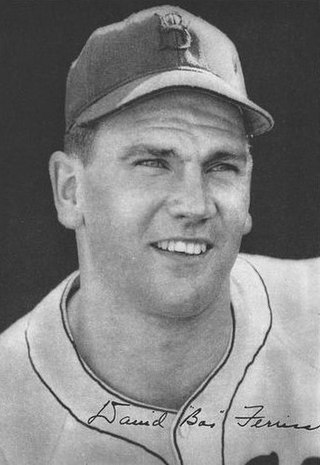
David Meadow Ferriss was an American Major League Baseball player who pitched for the Boston Red Sox from 1945 through 1950. Ferriss was given the nickname 'Boo' as the result of a childhood inability to pronounce the word 'brother'.

Charles Thomas Wagner was an American right-handed pitcher in Major League Baseball who played his entire, 100-game career for the Boston Red Sox. Nicknamed "Broadway," after his playing retirement he went on to a 60-year career as a farm system supervisor, scout, major-league pitching coach and minor-league instructor. His professional relationship with the Red Sox lasted a record 73 years.

Michael Franklin "Pinky" Higgins was an American third baseman, manager, front office executive and scout in Major League Baseball who played for three teams and served as manager or general manager of the Boston Red Sox during the period of 1955 through 1965. During his playing days, he batted and threw right-handed, and was listed as 6 feet 1 inch (1.85 m) tall and 185 pounds (84 kg).

The Mad Dash, or Slaughter's Mad Dash, refers to an event in the eighth inning of the seventh game of the 1946 World Series between the St. Louis Cardinals and the Boston Red Sox.

Paul Howard "Dizzy" Trout was an American professional baseball player. He played in Major League Baseball as a right-handed pitcher from 1939 to 1952, most notably as a member of the Detroit Tigers team that finished either in first or second place in the American League pennant races between 1944 and 1947 and won the 1945 World Series. The two-time All-Star player was the American League wins leader in 1943 and, was the league ERA leader in 1944. In 1957, Trout made a brief comeback attempt at the age of 42 with the Baltimore Orioles. He also played for the Boston Red Sox.

A "cup of coffee" is a North American sports idiom for a short time spent by a minor league player at the major league level. The idea behind the term is that the player was only in the big leagues long enough to have a cup of coffee before being returned to the minors. The term originated in baseball and is extensively used in ice hockey, both of whose professional leagues utilize extensive farm systems; it is rarely used in basketball or American football since neither the NBA nor NFL have implemented a true farm system.

Mace Stanley Brown was an American professional baseball player, scout and coach. He appeared in Major League Baseball, largely as a relief pitcher, over ten seasons for the Pittsburgh Pirates, Brooklyn Dodgers and Boston Red Sox. Brown posted a 76–57 record with a 3.46 ERA and 44 saves in 387 appearances.
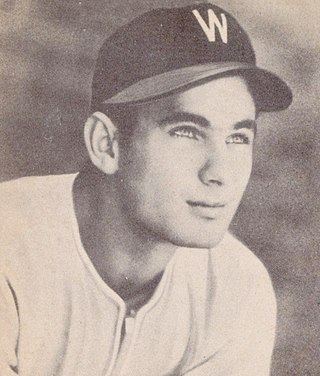
James Henry Bloodworth was an American professional baseball second baseman who played in Major League Baseball (MLB) for the Washington Senators, Detroit Tigers, Pittsburgh Pirates (1947), Cincinnati Reds (1949–50), and Philadelphia Phillies (1950–51).

Harry Edwards Gumbert, nicknamed "Gunboat", was an American pitcher in Major League Baseball whose career extended for 21 professional seasons, including 15 years and 508 games pitched in the big leagues. He threw right-handed and was listed at 6 feet 2 inches (1.88 m) tall and 185 pounds (84 kg). Gumbert was born in Elizabeth, Pennsylvania, and was the great-nephew of two 19th-century major league players, Ad and Billy Gumbert.

Robert Harold Klinger was a professional baseball player who was a right-handed pitcher in Major League Baseball over parts of eight seasons from 1938 through 1947. He played for the Pittsburgh Pirates and the Boston Red Sox. In 265 career appearances he compiled a 66–61 record along with 23 saves, with a 3.68 earned run average and 357 strikeouts. His cousin Charlie Hollocher was also a Major League Baseball player.

Dario Antonio Lodigiani was an American infielder in Major League Baseball who played for two different teams between 1938 and 1946. Listed at 5'8", 150 lb., he batted and threw right-handed. He was born in San Francisco, California. Lodigiani enjoyed a 17-year baseball career (1935–1954), playing parts of six seasons in the majors and 14 in the minor leagues, losing three years while serving in the military (1943–45).
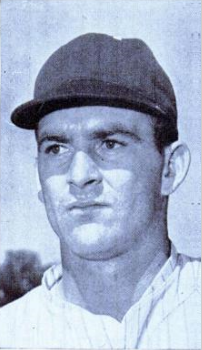
Neill Rawlins Sheridan, nicknamed "Wild Horse," was an American professional baseball player whose 12-season career (1943–1954) largely took place in the minor leagues. An outfielder by trade, he saw his only Major League service for the 1948 Boston Red Sox, appearing for a cup of coffee — one as a pinch hitter and one as a pinch runner. Born in Sacramento, California, Sheridan threw and batted right-handed; he stood 6 feet 1 inch (1.85 m) tall and weighed 195 pounds (88 kg).

Walter John Hriniak is an American former catcher in American Major League Baseball who—despite a very brief MLB playing career and a batting average of only .253—became one of the most prominent batting coaches in the game during the last two decades of the 20th century. As a player, he stood 5 feet 11 inches (1.80 m) tall, weighed 178 pounds (81 kg), batted left-handed and threw right-handed. He was born in Natick, Massachusetts.

The 1946 Major League Baseball All-Star Game was the 13th playing of the "Midsummer Classic" by Major League Baseball's (MLB) American League (AL) and National League (NL) All-Star teams.
Robert Shaw "Buck" Fausett, also nicknamed "Leaky", was an American professional baseball player and manager. A 19-year veteran minor leaguer who got into over 2,200 games, mostly in higher-level circuits, he appeared in 13 major league contests for the 1944 Cincinnati Reds during the World War II manpower shortage. He was born in Sheridan, Arkansas, and attended East Texas State Teachers College. Fausett batted left-handed, threw right-handed, and was listed as 5 feet 10 inches (1.78 m) tall and 170 pounds (77 kg).
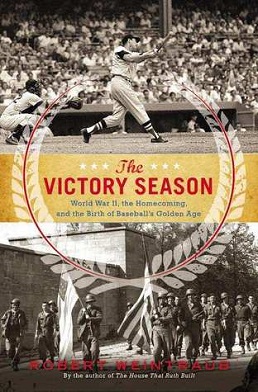
The Victory Season: The End of World War II and the Birth of Baseball's Golden Age is a 2013 book written by Robert Weintraub whose previous work includes the New York Times best-sellerThe House That Ruth Built.

Warren Sandel was an American baseball player from 1938 to 1952. Most of his playing time was spent at the minor league level. A pitcher, Sandel is best remembered for giving up the first base hit to Jackie Robinson who broke professional baseball's color barrier in 1946 while playing under a minor league contract for the Brooklyn Dodgers.




















